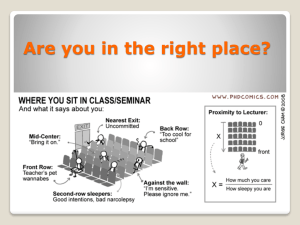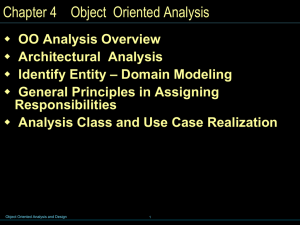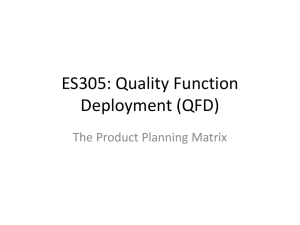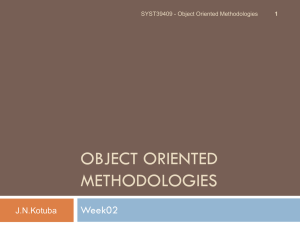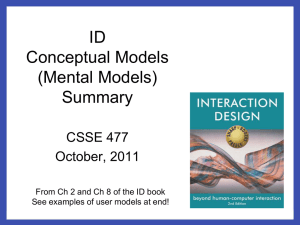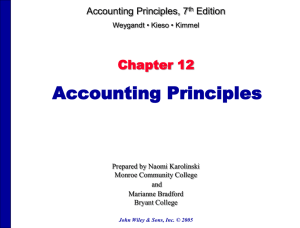Chap 4 - Object Oriented Analysis
advertisement
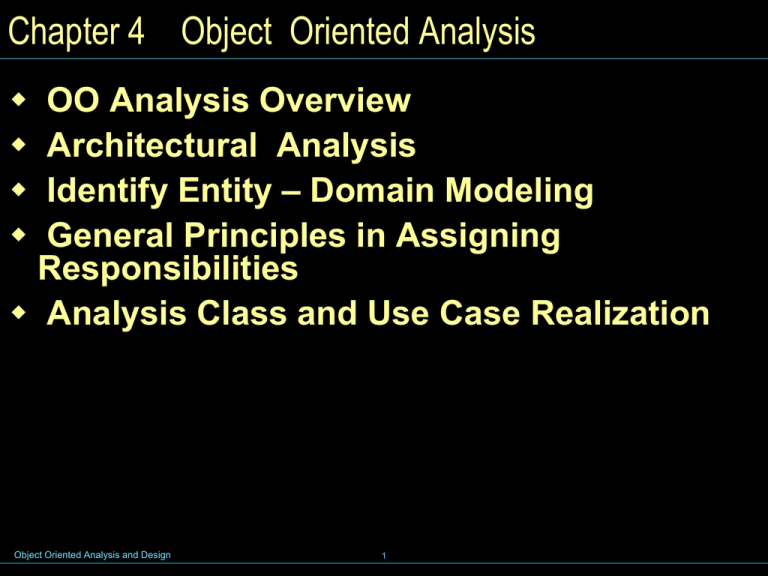
Chapter 4 Object Oriented Analysis OO Analysis Overview Architectural Analysis Identify Entity – Domain Modeling General Principles in Assigning Responsibilities Analysis Class and Use Case Realization Object Oriented Analysis and Design 1 OO Analysis Overview Object Oriented Analysis and Design 2 4.1 OO Analysis Overview Understanding Analysis Analysis Versus Design Object Oriented Analysis Three ways to do Object Oriented Analysis Object Oriented Analysis and Design 3 Understanding Analysis In software engineering, analysis is the process of converting the user requirements to system specification system means the software to be developed. System specification, also known as the logic structure, is the developer’s view of the system. Function-oriented analysis – concentrating on the decomposition of complex functions to simply ones. Object-oriented analysis – identifying objects and the relationship between objects. Object Oriented Analysis and Design 4 Understanding Analysis The goal in Analysis is to understand the problem and to begin to develop a visual model of what you are trying to build, independent of implementation and technology concerns. Analysis focuses on translating the functional requirements into software concepts. The idea is to get a rough cut at the objects that comprise our system, but focusing on behavior (and therefore encapsulation). We then move very quickly, nearly seamlessly into “design” and the other concerns. Object Oriented Analysis and Design 5 Analysis Versus Design Analysis Design Focus on understanding the problem Idealized design Behavior System structure Functional requirements A small model Object Oriented Analysis and Design Focus on understanding the solution Operations and Attributes Performance Close to real code Object lifecycles Non-functional requirements A large model 6 Object Oriented Analysis Identifying objects: Using concepts, CRC cards, stereotypes, etc. Organising the objects: classifying the objects identified, so similar objects can later be defined in the same class. Identifying relationships between objects: this helps to determine inputs and outputs of an object. Defining operations of the objects: the way of processing data within an object. Defining objects internally: information held within the objects. Object Oriented Analysis and Design 7 Three ways to do Object Oriented Analysis Conceptual model (Larman) Produce a “light” class diagram. CRC cards (Beck, Cunningham) Index cards and role playing. Analysis model with stereotypes (Jacobson) Boundaries, entities, control. Object Oriented Analysis and Design 8 Architectural Analysis Object Oriented Analysis and Design 9 4.2 Architectural Analysis Architectural Analysis Identification and Analysis of Architectural Factors Summary of Themes in Architectural Analysis Object Oriented Analysis and Design 10 Architectural Analysis Architectural analysis is concerned with the identification and resolution of the system's non-functional (for example, quality) requirements, in the context of the functional requirements In the UP, the term encompasses both architectural investigation (identification) and architectural design (resolution) Object Oriented Analysis and Design 11 Architectural Analysis - Purpose To define a candidate architecture for the system, based on experience gained from similar systems or in similar problem domains. To define the architectural patterns, key mechanisms and modeling conventions for the system. To define the reuse strategy To provide input to the planning process Object Oriented Analysis and Design 12 Design Model Overview Requirement Model Design Model Use case Use case realization Layered Architecture Use case report <<layer>> Special Application <<layer>> General Application Glossary <<layer>> General Services <<layer>> System Services Supplementary Specification Object Oriented Analysis and Design Architecture Mechanism 13 Common Steps in Architectural Analysis Identify and analyze the non-functional requirements that have an impacton the architecture. Functional requirements are also relevant (especially in terms of variability or change), but the non-functional are given thorough attention. In general, all these may be called architectural factors (also known as the architectural drivers) For those requirements with a significant architectural impact, analyze alternatives and create solutions that resolve the impact. These are architectural decisions. Object Oriented Analysis and Design 14 Identification and Analysis of Architectural Factors Architectural Factors Quality Scenarios Factor Table Factors and UP Artifacts Object Oriented Analysis and Design 15 Quality Scenarios When defining quality requirements during architectural factor analysis, quality scenarios are recommended, as they define measurable (or at least observable) responses, and thus can be verified. It is not much use to vaguely state "the system will be easy to modify" without some measure of what that means. Quantifying some things, such as performance goals and mean time between failure, are well known practices, but quality scenarios extend this idea and encourages recording all (or at least, most) factors as measurable statements. Quality scenarios are short statements of the form <stimulus> <measurable response>; for example: When the completed sale is sent to the remote tax calculator to add the taxes, the result is returned within 2 seconds "most" of the time, measured in a production environment under "average" load conditions. When a bug report arrives from a NextGen beta test volunteer, reply with a phone call within 1 working day. Object Oriented Analysis and Design 16 Factor Table Most architectural methods advocate creating a table or tree with variations of the following information. The following style shown in Table is called a factor table, which in the UP is part of the Supplementary Specification Object Oriented Analysis and Design 17 Factors and UP Artifacts The central functional requirements repository in the UP are the use cases, and they, along with the Vision and Supplementary Specification, are an important source of inspiration when creating a factor table. In the use cases, the Special Requirements,Technology Variations, and Open Issues should be reviewed, and their implied or explicit architectural factors consolidated in the Supplementary Specification. Object Oriented Analysis and Design 18 Example: Partial NextGen POS Architectural Factor Table Object Oriented Analysis and Design 19 Summary of Themes in Architectural Analysis "architectural" concerns are especially related to nonfunctional requirements, and include an awareness of the business or market context of the application. At the same time, the functional requirements (for example, processing sales) cannot be ignored; they provide the context within which these concerns must be resolved. Further,identification of their variability is architecturally significant. architectural concerns involve system-level,large-scale, and broad problems whose resolution usually involves large-scale or fundamental design decisions for example, the choice of—or even use of—an application server. interdependencies and trade-offs. For example, improved security may affect performance or usability, and most choices affect cost. the generation and evaluation of alternative solutions Object Oriented Analysis and Design 20 Architectural Information in the UP Artifacts The architectural factors (for example, in a factor table) are recorded in the Supplementary Specification. Object Oriented Analysis and Design 21 Identify Entity – Domain Modeling Object Oriented Analysis and Design 22 4.3 Identify Entity – Domain Modeling Visualizing Concepts Adding Associations Adding Attributes Modeling Generalization Refining the Domain Model Object Oriented Analysis and Design 23 VISUALIZING CONCEPTS Domain Models Conceptual Class Identification Domain Modeling Guidelines Resolving Similar Conceptual Classes Modeling the Unreal world Specification Conceptual Classes UML Notation v.s. Methodology Lowering the Representational Gap Domain Models within the UP Object Oriented Analysis and Design 24 Domain Models A domain model is a representation of real-world conceptual classes not a representation of software components. not a set of diagrams describing software classes, not software objects with responsibilities. A domain model is a visual representation of conceptual classes or real-world objects in a domain of interest [MO95, Fowler96] They have also been called conceptual models, domain object models, and analysis object models. The UP defines a Domain Model as one of the artifacts that may be created in the Business Modeling discipline. Object Oriented Analysis and Design 25 Domain Models Using UML notation, a domain model is illustrated with a set of class diagrams in which no operations are defined. It may show: domain objects or conceptual classes associations between conceptual classes attributes of conceptual classes Object Oriented Analysis and Design 26 Domain Models The domain model illustrates conceptual classes or vocabulary in the domain. Domain Models are not models of software components. The following elements are not suitable in a domain model: Software artifacts, such as a window or a database, unless the domain being modeled is of software concepts, such as a model of graphical user interfaces. Responsibilities or methods. Object Oriented Analysis and Design 27 Domain Models The domain model illustrates conceptual classes or vocabulary in the domain. Informally, a conceptual class is an idea, thing, or object. More formally, a conceptual class may be considered in terms of its symbol, intension, and extension[MO95]. Symbol—words or images representing a conceptual class. Intension—the definition of a conceptual class. Extension—the set of examples to which the conceptual class applies. Object Oriented Analysis and Design 28 Domain Models Software problems can be complex; Decomposition (divide-and-conquer) is a common strategy to deal with this complexity by division of the problem space into comprehensible units. In structured analysis, the dimension of decomposition is by processes or functions. However, in object-oriented analysis, the dimension of decomposition is fundamentally by things or entities in the domain. A central distinction between object-oriented and structured analysis is: division by conceptual classes (objects) rather than division by functions. A primary analysis task is to identify different concepts in the problem domain and document the results in a domain model Object Oriented Analysis and Design 29 Conceptual Class Identification A useful guideline in identifying conceptual classes: It is better to overspecify a domain model with lots of finegrained conceptual classes than to underspecify it. Strategies to Identify Conceptual Classes. Use a conceptual class category list. Finding conceptual classes with Noun Phrase Identification Another excellent technique for domain modeling is the use of analysis patterns, which are existing partial domain models created by experts, using published resources such as Analysis Patterns [Fowler96] and Data Model Patterns[Hay96]. Object Oriented Analysis and Design 30 Conceptual Classes A conceptual class is a real-world concept or thing; a conceptual or essential perspective. At the noun filtering stage we are looking for conceptual classes. As we move through the design process we will start to design software classes that represent an implementation perspective of a software component but we will not get into language specific classees. A conceptual class is not an implementation class, such as a class that can be implemented in an OO language such as Java or C++. That comes much later. Object Oriented Analysis and Design 31 Conceptual Class Category Physical or tangible objects Specifications, deigns or descriptions of things Places Transactions Transaction line items Roles of people Containers of other things Things in a container Other computer or electro-mechanical systems external to the system Organizations Events Rules and policies Catalogs Records of finance, work, contracts, legal matters Financial instruments and services Manuals, documents, reference papers, books Object Oriented Analysis and Design Examples Register, Airplane ProductSpecification, FlightDescription Store, Airport Sale, Payment, Reservation SalesLineItem Cashier, Pilot Store, Bin, Airplane Item, Passenger CreditPaymentAuthorizationSystem AirTrafficControl SalesDepartment, ObjectAirline Sale, Payment, Meeting, Flight, Crash, Landing RefundPolicy CancellationPolicy ProductCatalog, PartsCatalog Receipt, Ledger, EmploymentContract, MaintenanceLog LineOfCredit, Stock DailyPriceChangeList , RepairManual 32 Domain Modeling Guidelines How to Make a Domain Model 1. List the candidate conceptual classes using the Conceptual Class Category List and noun phrase identification techniques related to the current requirements under consideration. 2. Draw them in a domain model. 3. Add the associations necessary to record relationships for which there is a need to preserve some memory. 4. Add the attributes necessary to fulfill the information requirements. On Naming and Modeling Things use the vocabulary of the domain when naming conceptual classes and attributes. • For example, if developing a model for a library, name the customer a "Borrower" or "Patron"—the terms used by the library staff. a domain model may exclude conceptual classes in the problem domain not pertinent to the requirements. • For example, we may exclude Pen and PaperBag from our domain model (for the current set of requirements) since they do not have any obvious noteworthy role. the domain model should exclude things not in the problem domain consideration. Object Oriented under Analysis and Design 33 Domain Modeling Guidelines A Common Mistake in Identifying Conceptual Classes Perhaps the most common mistake when creating a domain model is to represent something as an attribute when it should have been a concept. A rule of thumb to help prevent this mistake is: • If we do not think of some conceptual class X as a number or text in the real world, X is probably a conceptual class, not an attribute. As an example, should store be an attribute of Sale, or a separate conceptual class Store? In the real world, a store is not considered a number or text - the term suggests a legal entity, an organization, and something occupies space. Therefore, Store should be a concept. As another example, consider the domain of airline reservations. Should destination be an attribute of Flight, or a separate conceptual class Airport? In the real world, a destination airport is not considered a number or text—it is a massive thing that occupies space. Therefore, Airport should be a concept. Object Oriented Analysis and Design 34 Resolving Similar Conceptual Classes As a example, in the domain model, should the symbol Register be used instead of POST? POST" is a term familiar in the territory, so it is a useful symbol from the point of view of familiarity and communication. By the goal of creating models that represent abstractions and are implementation independent, Register is appealing and useful. As a rule of thumb, a domain model is not absolutely correct or wrong, but more or less useful; it is a tool of communication. Object Oriented Analysis and Design 35 Modeling the Unreal world Some software systems are for domains that find very little analogy in natural or business domains; software for telecommunications is an example. It is still possible to create a domain model in these domains, but it requires a high degree of abstraction and stepping back from familiar designs. For example, here are some candidate conceptual classes related to a telecommunication switch: Message, Connection, Port, Dialog, Route, Protocol. Object Oriented Analysis and Design 36 Specification or Description Conceptual Classes Specifications or descriptions about other things. Object Oriented Analysis and Design 37 Specification or Description Conceptual Classes Add a specification or description conceptual class (for example, ProductSpecification) when: There needs to be a description about an item or service, independent of the current existence of any examples of those items or services. Deleting instances of things they describe (for example, Item) results in a loss of information that needs to be maintained, due to the incorrect association of information with the deleted thing. It reduces redundant or duplicated information. Object Oriented Analysis and Design 38 UML Notation v.s. Methodology The UML simply describes raw diagram types, such as class diagrams and sequence diagrams. It does not superimpose a method or modeling perspective on these. Rather, a process (such as the UP) applies raw UML in the context of methodologist-defined models. Three perspectives and types of models: Conceptual perspective • the diagrams are interpreted as describing things in the real world or domain of interest. Specification perspective • the diagrams are interpreted as describing software abstractions or • components with specifications and interfaces, but no commitment to a particular implementation (for example, not specifically a class in C# or Java). Implementation perspective • the diagrams are interpreted as describing software implementations in a particular technology and language (such as Java). Object Oriented Analysis and Design 39 Lowering the Representational Gap The Domain Model provides a visual dictionary of the domain vocabulary and concepts from which to draw inspiration for the naming of some things in the software design. In object design and programming it is common to create software classes whose names and information is inspired from the real world domain. Object Oriented Analysis and Design 40 Domain Models within the UP Domain models are not strongly motivated in inception, since inception's purpose is not to do a serious investigation, but rather to decide if the project is worth deeper investigation in an elaboration phase. The Domain Model is primarily created during elaboration iterations, when the need is highest to understand the noteworthy concepts and map some to software classes during design work. Object Oriented Analysis and Design 41 Domain Models within the UP The UP Domain Model is an official variation of the less common UP Business Object Model (BOM). [The UP BOM] serves as an abstraction of how business workers and business entities need to be related and how they need to collaborate in order to perform the business. [RUP] The BOM is represented with several different diagrams (class, activity, and sequence) that illustrate how the entire enterprise runs (or should run). It is most useful if doing enterprise-wide business process engineering, but that is a less common activity than creating a single software application. Consequently, the UP defines the Domain Model as the more commonly created subset artifact or specialization of the BOM. Object Oriented Analysis and Design 42 Domain Models within the UP Artifact influence emphasizing the Domain Model Object Oriented Analysis and Design 43 Adding Association Associations The UML Association Notation Finding Associations Association Guidelines Roles How Detailed Should Associations Be? Naming Associations Multiple Associations Between Two Types Associations and Implementation Example Object Oriented Analysis and Design 44 Associations An association is a relationship between types (or more specifically, instances of those types) that indicates some meaningful and interesting connection In the UML associations are defined as "the semantic relationship between two or more classifiers that involve connections among their instances.“ Criteria for Useful Associations Associations for which knowledge of the relationship needs to be preserved for some duration ("need-to-know" associations). Associations derived from the Common Associations List. Object Oriented Analysis and Design 45 The UML Association Notation An association is represented as a line between classes with an association name. The association is inherently bidirectional, meaning that from instances of either class, logical traversal to the other is possible. This traversal is purely abstract; it is not a statement about connections between software entities. The ends of an association may contain a multiplicity expression indicating the numerical relationship between instances of the classes. An optional "reading direction arrow" indicates the direction to read the association name; it does not indicate direction of visibility or navigation. Object Oriented Analysis and Design 46 Finding Associations Start the addition of associations by using the Common Associations List It contains common categories that are usually worth considering. Here are some high-priority association categories that are invariably useful to include in a domain model: A is a physical or logical part of B. A is physically or logically contained in/on B. A is recorded in B. Object Oriented Analysis and Design 47 Association Guidelines Focus on those associations for which knowledge of the relationship needs to be preserved for some duration ("need-to-know" associations). It is more important to identify conceptual classes than to identify associations. Too many associations tend to confuse a domain model rather than illuminate it. Their discovery can be time-consuming, with marginal benefit. Avoid showing redundant or derivable associations. Object Oriented Analysis and Design 48 Roles Each end of an association is called a role. Roles may optionally have: name multiplicity expression navigability Object Oriented Analysis and Design 49 Naming Associations Name an association based on a TypeNameVerbPhrase-TypeName format where the verb phrase creates a sequence that is readable and meaningful in the model context. Object Oriented Analysis and Design 50 Multiple Associations Between Two Types Two types may have multiple associations between them; this is not uncommon. Object Oriented Analysis and Design 51 Associations and Implementation During domain modeling, an association is not a statement about data flows, instance variables, or object connections in a software solution; it is a statement that a relationship is meaningful in a purely conceptual sense—in the real world. Object Oriented Analysis and Design 52 Example The following sample of associations is justified in terms of a need-to-know. It is based on the use cases currently under consideration. Object Oriented Analysis and Design 53 Example-Applying the Category of Associations Checklist Object Oriented Analysis and Design 54 Example Object Oriented Analysis and Design 55 Example Object Oriented Analysis and Design 56 Adding Attributes Attributes VS. Associations Non-primitive Data Type Classes No Attributes as Foreign Keys Modeling Attribute Quantities and Units Object Oriented Analysis and Design 57 Attributes VS. Associations The attributes in a domain model should preferably be simple attributes or data types. Object Oriented Analysis and Design 58 Non-primitive Data Type Classes If the attribute class is a data type, it may be shown in the attribute box. Object Oriented Analysis and Design 59 Design Creep: No Attributes as Foreign Keys Attributes should not be used to relate conceptual classes in the domain model. The most common violation of this principle is to add a kind of foreign key attribute, as is typically done in relational database designs, in order to associate two types. Object Oriented Analysis and Design 60 Modeling Attribute Quantities and Units Most numeric quantities should not be represented as plain numbers. Object Oriented Analysis and Design 61 Modeling Generalization New Concepts for the Domain Model Generalization Defining Conceptual Superclasses and Subclasses Abstract Conceptual Classes Modeling Changing States Object Oriented Analysis and Design 62 Category Concepts List Category physical or tangible objects Examples CreditCard, Check Transactions CashPayment, CreditPayment, CheckPayment other computer or electromechanical systems external to our system CreditAuthorizationService, CheckAuthorizationService abstract noun concepts organizations CreditAuthorizationService, CheckAuthorizationService records of finance, work, contracts, legal matters AccountsReceivable Object Oriented Analysis and Design 63 Noun Phrase Identification from the Use Cases Use Case UC1: Process Sale 7b. Paying by credit: 1. Customer enters their credit account information. 2. System sends payment authorization request to an external Payment Authorization Service System, and requests payment approval. 2a. System detects failure to collaborate with external system: 1. System signals error to Cashier. 2. Cashier asks Customer for alternate payment. 3. System receives payment approval and signals approval to Cashier. 3a. System receives payment denial: 1. System signals denial to Cashier. 2. Cashier asks Customer for alternate payment. 4. System records the credit payment, which includes the payment approval. 5. System presents credit payment signature input mechanism. 6. Cashier asks Customer for a credit payment signature. Customer enters signature. Object Oriented Analysis and Design 64 Noun Phrase Identification from the Use Cases Use Case UC1: Process Sale 7c. Paying by check: 1. The Customer writes a check, and gives it and their driver's license to the Cashier. 2. Cashier writes the driver's license number on the check, enters it, and requests check payment authorization. 3. Generates a check payment request and sends it to an external Check Authorization Service. 4. Receives a check payment approval and signals approval to Cashier. 5. System records the check payment, which includes the payment approval. Object Oriented Analysis and Design 65 generalization-specialization class hierarchy The concepts CashPayment, CreditPayment, and Check Payment are all very similar. Object Oriented Analysis and Design 66 Conceptual Subclass Definition Conformance All Payment subclasses must conform to having an amount and paying for a Sale. 100% Rule The subclass must conform to 100% of the superclass's: • attributes • associations Object Oriented Analysis and Design 67 Conceptual Subclass Set Conformance CreditPayment should be a member of the set of Payments. CheckPayment is a kind of Payment. Is-a Rule All the members of a subclass set must be members of their superclass set. Object Oriented Analysis and Design 68 When to Define a Conceptual Subclass? A potential subclass should conform to the: 100% Rule (definition conformance) Is-a Rule (set membership conformance) Object Oriented Analysis and Design 69 What Is a Correct Conceptual Subclass? Create a conceptual subclass of a superclass when: The subclass has additional attributes of interest. The subclass has additional associations of interest. The subclass concept is operated on, handled, reacted to, or manipulated differently than the superclass or other subclasses, in ways that are of interest. The subclass concept represents an animate thing (for example, animal,robot) that behaves differently than the superclass or other subclasses,in ways that are of interest. Object Oriented Analysis and Design 70 Example subclass partitions Object Oriented Analysis and Design 71 NextGen POS Conceptual Class Hierarchies Object Oriented Analysis and Design 72 NextGen POS Conceptual Class Hierarchies Object Oriented Analysis and Design 73 Concepts too fine grained? Object Oriented Analysis and Design 74 Concepts too fine grained? Object Oriented Analysis and Design 75 Abstract Conceptual Classes Object Oriented Analysis and Design 76 Abstract Class Notation in the UML Object Oriented Analysis and Design 77 Modeling Changing States Do not model the states of a concept X as subclasses of X. Rather, either: Define a state hierarchy and associate the states with X, or Ignore showing the states of a concept in the domain model; show the states in state diagrams instead.. Object Oriented Analysis and Design 78 Refining the domain model Association Classes Aggregation and Composition Roles as Concepts vs. Roles in Associations Qualified Associations Reflexive Associations Using Packages to Organize the Domain Model Object Oriented Analysis and Design 79 Association Classes Object Oriented Analysis and Design 80 Association Classes Clues that an association class might be useful in a domain model: An attribute is related to an association. Instances of the association class have a life-time dependency on the association. There is a many-to-many association between two concepts, and information associated with the association itself... Object Oriented Analysis and Design 81 Aggregation A special form of association that models a whole-part relationship between an aggregate (the whole) and its parts Whole Part Schedule Student Aggregation Object Oriented Analysis and Design 82 Composition A form of aggregation with strong ownership and coincident lifetimes The parts cannot survive the whole/aggregate Part Whole Student Schedule Composition Object Oriented Analysis and Design 83 Roles as Concepts vs. Roles in Associations In a domain model, a real-world role—especially a human role—may be modeled in a number of ways, such as a discrete concept (roles as concepts), or expressed as a role in an association (roles in associations). Object Oriented Analysis and Design 84 Qualified Associations A qualifier may be used in an association; it distinguishes the set of objects at the far end of the association based on the qualifier value. An association with a qualifier is a qualified association. Object Oriented Analysis and Design 85 Reflexive Associations A concept may have an association to itself; this is known as a reflexive association Object Oriented Analysis and Design 86 Using Packages to Organize the Domain Model Object Oriented Analysis and Design 87 Using Packages to Organize the Domain Model Object Oriented Analysis and Design 88 Using Packages to Organize the Domain Model Object Oriented Analysis and Design 89 Using Packages to Organize the Domain Model Object Oriented Analysis and Design 90 Using Packages to Organize the Domain Model Object Oriented Analysis and Design 91 General Principles in Assigning Responsibilities Object Oriented Analysis and Design 92 4.4 General Principles in Assigning Responsibilities Responsibilities Responsibility-Driven Design CRC Cards GRASP Object Oriented Analysis and Design 93 Responsibilities The UML defines a responsibility as "a contract or obligation of a classifier" A knowing or doing service or group of services provided by an element (such as a class or subsystem); A responsibility embodies one or more of the purposes or obligations of an element. A popular way of thinking about the design of software objects and also larger-scale components is in terms of responsibilities, roles, and collaborations. Object Oriented Analysis and Design 94 Responsibilities Doing responsibilities of an object include: doing something itself, such as creating an object or doing a calculation initiating action in other objects controlling and coordinating activities in other objects Knowing responsibilities of an object include: knowing about private encapsulated data knowing about related objects knowing about things it can derive or calculate For example "a Sale is responsible for creating SalesLineItems" (a doing), "a Sale is responsible for knowing its total" (a knowing). Object Oriented Analysis and Design 95 Responsibility-Driven Design (RDD) A general metaphor for thinking about OO software design RDD leads to viewing an OO analysis & design as a community of collaborating responsible objects. RDD also includes the idea of collaboration. Responsibilities are implemented by means of methods that either act alone or collaborate with other methods and objects. In RDD, Responsibilities are related to the obligations or behavior of an object in terms of its role. Object Oriented Analysis and Design 96 CRC cards CRC stands for Class-ResponsibilityCollaborator. They look like: Name Responsibilities Collaborators one per class, which shows its responsibilities and with which other class(es) it must collaborate in order to fulfill each responsibility. Write a brief description of the class on the back of the card. CRC cards are useful in detecting responsibilities of objects (developed by Kent Beck and Ward Cunningham). Object Oriented Analysis and Design 97 CRC Cards - Example In this example, class Foo must collaborate with (send messages to) classes X & Y in order to fulfill its responsibility to be able to “do something.” Class Name Foo RESPONSIBILITIES COLLABORATIONS Do something Classes X & Y Object Oriented Analysis and Design 98 GRASP : General Principles in Assigning Responsibilities Creator Information Expert Low Coupling Controller High Cohesion Object Oriented Analysis and Design 99 GRASP - Creator Problem: Who creates an A? Solution Assign class B the responsibility to create an instance of class A if one of these is true (the more the better): • B "contains" or compositely aggregates A. • B records A. • B closely uses A. • B has the initializing data for A. Object Oriented Analysis and Design 100 GRASP - Information Expert Problem: What is a basic principle by which to assign responsibilities to objects? Solution Assign a responsibility to the class that has the information needed to fulfill it. Object Oriented Analysis and Design 101 GRASP - Low Coupling Problem: How to reduce the impact of change? Solution Assign responsibilities so that (unnecessary) coupling remains low. Use this principle to evaluate alternatives. Object Oriented Analysis and Design 102 GRASP - Controller Problem: What first object beyond the UI layer receives and coordinates ("controls") a system operation? Solution Assign the responsibility to an object representing one of these choices: • Represents the overall "system," a "root object," a device that the software is running within, or a major subsystem (these are all variations of a facade controller). • Represents a use case scenario within which the system operation occurs (a use case or session controller) Object Oriented Analysis and Design 103 GRASP - Low Coupling Problem: How to keep objects focused, understandable, and manageable, and as a side effect, support Low Coupling? Solution Assign responsibilities so that cohesion remains high. Use this to evaluate alternatives. Object Oriented Analysis and Design 104 Analysis Class and Use Case Realization Object Oriented Analysis and Design 105 4.5 Analysis Class and Use Case Realization What is an Analysis Class? Use Case Realization Object Oriented Analysis and Design 106 What is an Analysis Class? Analysis classes represent an early conceptual model for ‘things in the system which have responsibilities and behavior’. Analysis classes are used to capture a ‘firstdraft’, rough-cut of the object model of the system. Analysis classes handle primarily functional requirements. They model objects from the problem domain. Object Oriented Analysis and Design 107 What is an Analysis Class? There are three aspects of the system that are likely to change: the boundary between the system and its actors, the information the system uses, and the control logic of the system. behaviour information boundary Object Oriented Analysis and Design 108 What is an Analysis Class? In an effort to isolate the parts of the system that will change, different types of analysis classes are identified with a “canned” set of responsibilities: boundary, entity and control classes. Control entity boundary Object Oriented Analysis and Design 109 What is an Analysis Class? <<boundary>> System boundary <<control>> Use-case behavior coordination System information Object Oriented Analysis and Design 110 <<entity>> Analysis Classes: A First Step Towards Executables Use Cases Analysis Classes Design Elements Use-Case Analysis Object Oriented Analysis and Design 111 Source Code Exec What is a Boundary Class? Intermediates between the interface and something outside the system Several Types User interface classes System interface classes Device interface classes One boundary class per actor/use case pair Analysis class stereotype Environment Dependent Object Oriented Analysis and Design 112 The Role of a Boundary Class <<boundary>> <<control>> <<boundary>> Customer <<boundary>> <<entity>> <<entity>> Model interaction between the system and its environment Object Oriented Analysis and Design 113 Example: Finding Boundary Classes One boundary class per actor/use case pair Student Register for Courses RegisterForCoursesForm Object Oriented Analysis and Design Course Catalog System CourseCatalogSystem 114 Guidelines: Boundary Class User Interface Classes Concentrate on what information is presented to the user Do NOT concentrate on the UI details System and Device Interface Classes Concentrate on what protocols must be defined Do NOT concentrate on how the protocols will be implemented Concentrate on the responsibilities, not the details! Object Oriented Analysis and Design 115 What is an Entity Class? Key abstractions of the system Analysis class stereotype Glossary Use Case Business-Domain Model Architectural Analysis Abstractions Environment Independent Object Oriented Analysis and Design 116 The Role of an Entity Class <<boundary>> <<control>> <<boundary>> Customer <<boundary>> <<entity>> <<entity>> Store and manage information in the system Object Oriented Analysis and Design 117 Example: Finding Entity Classes Use use-case flow of events as input Key abstractions of the use case Traditional, filtering nouns approach Underline noun clauses in the use-case flow of events Remove redundant candidates Remove vague candidates Remove actors (out of scope) Remove implementation constructs Remove attributes (save for later) Remove operations Object Oriented Analysis and Design 118 Example: Candidate Entity Classes Register for Courses (Create Schedule) CourseOffering Schedule Student Object Oriented Analysis and Design 119 What is a Control Class? Use-case behavior coordinator One control class per use case Use Case Analysis class stereotype Use-case dependent, Environment independent Object Oriented Analysis and Design 120 The Role of a Control Class <<boundary>> <<control>> <<boundary>> Customer <<boundary>> <<entity>> <<entity>> Coordinate the use-case behavior Object Oriented Analysis and Design 121 Example: Finding Control Classes One control class per use case Student Register for Courses RegistrationController Object Oriented Analysis and Design 122 Course Catalog System Example: Summary: Analysis Classes Student Register for Courses Course Catalog System CourseCatalogSystem Student Use-Case Model Design Model RegisterForCoursesForm CourseOffering Object Oriented Analysis and Design RegistrationController 123 Schedule Use-Case Realization A realization of a use case describes a collection of interacting objects which will support the functionality required by the use case Use-Case Model Use Case Design Model Use-Case Realization Sequence Diagrams Object Oriented Analysis and Design Class Diagrams 124 Collaboration Diagrams


